More actions
| Yanar | |
|---|---|
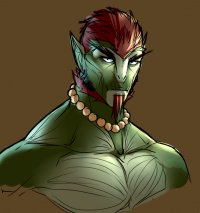 | |
| Race | |
| Pronunciation | Yah-nar |
| Classification | Florae |
| Subraces | None |
| Common Nicknames | Plant-People, Children of the Forest, Forestfolk |
| Languages | Modern Elven, Common |
| Naming Customs | Elven |
| Racial Traits | |
| Distinctions | Plant-like Humanoids with a mysterious past and dangerous future |
| Maximum Age | No limit, though the oldest Yanar is around 350 years old |
| Body Types | Varied, depending on Ovalation |
| Height | Varied, depending on Ovalation |
| Weight | Varied, depending on Ovalation |
| Eye Colors | Varied, depending on Ovalation |
| Hair Colors | Varied, depending on Ovalation |
| Skin Tones | Varied, though mostly green tones |
Wandering the forests of Daendroc and Teled Methen are the Yanar, a race of plant-like people thought to be the children of nature and the purest beings to walk the world of Aloria. In truth, the Yanar are neither of these, and they are far more enigmatic than their appearance makes them out to be. The Yanar were created by the Elven goddess Estel during the last decades of the Elven Empire, making them an artificial race. They were originally perceived to be the heralds of the goddess, but since the disappearance of Estel, both the role of the Yanar on Aloria and their relation to their creator has become far more complicated. Yanar are often entirely misunderstood; many of their race appears as innocent child-like plant people, or old decrepit bark walkers, yet in reality, they carry far-reaching responsibilities and goals which may yet affect the world in ways none could have ever conceived of.
Physical Characteristics
Yanar have no singular appearance that can be defined to represent their entire race. Yanar can be as large as Orcs, or as small as Dwarves; as frail as Cielothar, or as well-built as Avanthar. Their race knows no physical permanence, because they are able to re-shape their own physical appearance as time goes by. Yanar use Shape Essences to appear radically different depending on which essences they used to shape themselves. The act of consuming Shape Essences from the Ovalyte—a sort of Shape Essence producing gland that Yanar possess—is called Ovalating, which is explained more thoroughly below.
Aside from their commutable appearance, Yanar always retain some themes in common from shape-to-shape. Generally speaking, their skin consists of a green tone, while their humanoid silhouette is made up of plant-like materials. Where Ailor may have hair, leaves and other floral plumage exists. This plumage can vary greatly from Yanar to Yanar due to the effects of Ovalating, which also affects their eyes, teeth, body proportions, overall size, Body Build and facial structure. Many describe Yanar as an imitation of other Alorian races except made of plants, as they shape themselves in the resemblance of the others. Curiously, Yanar have no age limit, or at least not one that has been observed. The earliest Yanar were created around 50 BC and have still been found alive to this day, but many new Yanar are born each year, so not all Yanar are ancient. Still, some ancient Yanar exist from back in the days of the Elven Empire and the fall of the Nenya—personal witnesses to the doom of their beloved mother trees and Estel. That being said, few of these truly ancient Yanar remain as many died during violent conflicts after the collapse of the Elven Empire or the subsequent Ailor encroachment on the forests where they lived.
Internally, Yanar resemble much of the same as other races. They have humanoid-like internal organs that cause them to breathe, digest food, and have a heart beat. Their blood is however of a thicker consistency than for example Ailor blood, and is also dark green as opposed to red. Yanar do not physically bruise, nor can they break bones (as their bones are far more flexible than Ailor bones), though intense impact damage can shatter the plant material that their body is made of, meaning they still take heavy damage from falling high distances. Yanar skin is also notably weaker than Human skin. It is more susceptible to cuts and slices, and incredibly flammable, to the point where even high levels of heat pose a true threat to the race.
Yanar Reproduction
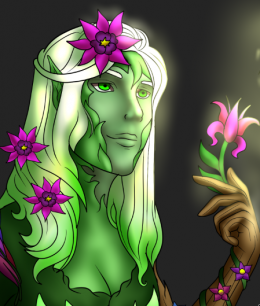
Yanar reproduction is one of the most hotly debated topics among some Yanar-focused scholars, in that they are the only race to (technically) reproduce asexually. Yanar completely lack the sexual organs of both genders, and can in fact not perform intercourse with any other race. They also do not need a partner to produce offspring. A Yanar may, once every year, enter a cycle of rebirth where a flower-like pod may be grown on their back. Every first day of May, Yanar enter a state of so called Rebirth-Will, where they contemplate all they have done in the past year and decide whether they have experienced enough to provide for a child. Ailor often misinterpret this as saying a Yanar should have earned an income to sustain their child, but this is not entirely true. When Yanar enter a cycle of rebirth, they impart the rough experiences, thoughts, and emotions of the past 12 months into the flower-like pod where the child will be born from. Through these experiences, the personality of the newborn Yanar will shape itself. If a Yanar for example has experienced a lot of death and sorrow, it may choose to reject the cycle of rebirth because the offspring from such experiences is assured to be defeatist, lacking in life-spirit and perpetually sad. If a Yanar has however experienced events of great pride, satisfaction, and communion with their family and friends, a child will be born with ambition, life-lust and social skills.
When the Yanar does willingly enter the cycle of rebirth, a small flower will form, usually on their back (though in some cases can also be on the stomach), which will grow over a period of three months. After three months, it is about the same size as the pregnant belly of an Ailor woman. The bearing Yanar will then feel it is ready and enter a state of euphoria before “giving birth” to the child, by sitting down and allowing it to crawl out of the flowery pod, which then wilts and falls off, leaving behind no markings or signs of ever having been there. The child that comes out will, at the time of birth, be a perfect miniature copy of the Yanar that gave birth to them. In physical appearance they will be identical, and in personality, they will take whatever emerges from the experiences the parent had in the past 12 months. A Yanar child grows to an adult within 10 days—the fastest maturing cycle witnessed among any race. They are still rather childish in those first 10 days, but function like proper adults when the period is roughly over, with some latent child-like personality traits present for a few months more. If a Yanar does not Ovalate during the child’s growth (or if the child does not Ovalate after becoming mature), parent and child will essentially be identical. Most Yanar children change their appearance very quickly after birth to differentiate themselves from their parent Yanar.
Despite the fact that Yanar do not have sexual organs or genitals, it does not mean that they cannot “make love” to each other, or other races. To Yanar, intercourse takes place on a more spiritual and emotional level than a physical one. When Yanar wish to engage someone in such an act, they gently place their hands under the recipient’s jawline, after which the two will close their eyes and clear their minds. If the recipient is willing, they will experience the Yanar’s affection in their mind and feel in a way that is almost indistinguishable from real physical intercourse. Yanar are, as such, still able to cultivate healthy relations with other races without the need to get very physical. They are often considered very clean lovers as such.
Yanar Ovalytes
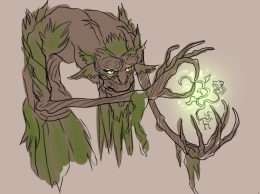
Yanar Ovalytes are a gland located underneath their tongue, which take the form of small tubes that excrete Shape Essences instead of saliva. Shape Essences act as a natural saliva and do not have any effects on the Yanar as long as they are not Ovalating: the process of imprinting the Shape Essence with the appearance of another humanoid race. When Yanar Ovalate (which can only be done on command, they cannot do it accidently), their fingertips begin to wetten in a manner similar to sweating, though Yanar do not actually have sweat glands nor can they naturally sweat. Instead, their fingertips are coated in a slightly sticky resin that feels rough when applied to another person’s skin, but not alarmingly so. When this resin scrapes the bare skin of another person, it harvests the Shape Flux of that person, which travels through the Yanar’s bloodstream to the Ovalyte, where Shape Essence is produced from a particular individual. The Yanar may then choose to swallow the Shape Essence, or to spit it out in a container where it can either be stored, or given to other Yanar for consumption. When Shape Essence finds itself outside the mouth of a Yanar, it hardens and takes on the taste of sweet candy.
When a Yanar consumes the Shape Essence of another race (Yanar can in fact not produce Shape Essence from other Yanar) they will slowly start to change their bodily make-up to resemble the template of the Shape Flux more. For example, a short, frail Yanar that consumes the Shape Essence of a large muscular Orc will experience muscular growth and height growth, while a male-appearing Yanar consuming the Shape Essence of a Varran Female may slowly procure female hips and plumage that resembles Varran fur on their body. Yanar don’t have a gender, so when consuming the Shape Essence of a male or female, they simply produce body aspects of said gender without truly becoming female or male.
Shape Essence changes are not instant. They are gradual and slow, and may take up to 24 hours to manifest fully. Furthermore, Shape Essence changes are mostly cosmetic beyond teeth and musculature, while consuming the Essence of for example a Maiar may grow a tail, it does not give the Yanar Maiar-like abilities like fast swimming and underwater breathing. The same applies to internal Orc organs and Varran eye-sight. The process is painless, though it can be alarming to Yanar who have never experienced it before or rarely do. A single session of Shape Essence consumption is not sufficient to make a Yanar completely morph their body. Seven or eight Shape Essence consumption sessions are necessary to completely change a Yanar to an eerily similar plant-like replica of the Shape Flux template, assuming they kept consuming the Shape Essence produced by the same person. It is thus possible to mediate between multiple people by switching between them each time Shape Essence is consumed, eventually resulting in a unique appearance that does not fully resemble any of the templates.
Shape Essence consumption does not have any effects on other races, it simply tastes like sweet candy to them. That being said, Shape Essence has been strongly hinted to have some potent alchemical uses. Most curiously of all, when a Yanar’s mouth is filled with the Shape Essence of a specific person, and their lips make physical contact with the original Shape Flux template, the kiss experienced will be intoxicating and incredibly pleasing. This is an ironic showcase of vanity where the Shape Flux template is essentially bombarded with feelings of self-lust while they aren’t aware of it.
Mental Characteristics
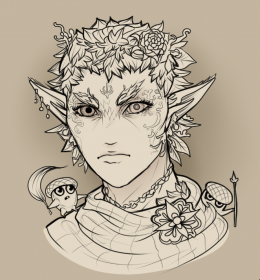
Yanar personalities, much like their physical appearance, are never truly set in stone. Yanar receive a certain codified personality upon their birth, but through experiences and feelings these personalities can change over the years. Furthermore, Yanar have two ways to influence their personality both permanently and temporarily. The main means of permanent personality change is through the process of Mind Tranquility, an act where a Yanar (during Yanar “love making") may accept the mind perceptions and emotional experiences of the other person. This does not transfer thoughts or memories, but rather the strong emotions that were tied to it; for example a feeling of intense loss and betrayal over a divorce, or happiness and satisfaction over a child. These can, if the Yanar permitted the Mind Tranquility to take place, seep into their personality and change it quite forcibly.
Another method to temporarily change a Yanar’s personality or mood is through the act of Bond Sharing. Bond Sharing is a mental ability that all Yanar possess, to be able to speak in a telepathic language with each other through touch. Additionally, while Bond Sharing is ongoing, all Yanar participating may choose to open their feelings to each other. In such a situation, a single Yanar may share a specific emotion with others through touch, which can have varying effects. For a Yanar who has experienced an extremely traumatic event, this can be very beneficial. By using a Bond Sharing to share this thought, the other Yanar that participate will share the burden with the sharer, which gives the Yanar participating an intense feeling of consolation and belonging. Alternatively, a Yanar can also share the immense pride and satisfaction of a child succeeding, which gives the other Yanar joyous feelings of happiness, at the cost of giving it away by the sharer. Bond Sharings have no limit. Two, seven, or even ten Yanar can all participate in a Bond Sharing as long as they are connected with each other. Speaking in such a Bond Sharing is not instant, it goes at about the same speed as normal speech, though simply occurs in the minds of those participating. There is one negative side-effect to Bond Sharing however, which is the temporary personality lingering. Even though sharing a traumatic experience helps the person who suffered it, it also imparts their sadness in part to the other Yanar. Similarly, if a Yanar tricks other Yanar into a Bond Sharing with hostile intentions, they could transfer intense feelings of hatred and violence to the others, causing them to potentially all erupt in a massive brawl.
Bond Sharing can also be used on non-sentient plants such as flowers, bushes, herbs, and even trees. When Bond Sharing with a plant, Yanar may “sing” through their mind to the plant with a telepathic melody. While performing this singing (often called Evergrowth), the plant matter they are Bonding with will experience rapid growth, to the point where smaller plants will grow visually as if weeks are passing (though the rate is much slower with trees). This is usually why Yanar houses are overgrown with plants and vines, as they are able to rapidly grow a garden around themselves almost anywhere as long as water and good soil is present. These Gardens are especially important for Yanar, because they tend to be the central locations where so called Yanar Colonies form. Yanar Colonies are explained more thoroughly in the Society Section.
History
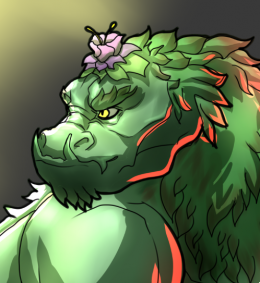
The Yanar first arrived in 40 BC on the eve of the Void Invasion, when Estel again attempted to warn her followers of impending doom from the Demonic forces. Elven priests of the Nenya temples watched as the colossal Nenya trees grew giant flowers as large as full-grown horses. The flowers rapidly wilted, shed their petals, and bore fruit that slowly bent to the floor, and it was from these fruits that the first Yanar burst forth and laid eyes on the world. Elven priests tried to heed the warnings that these Yanar delivered, but ultimately could not persuade their leaders to take action (largely due to the heightened arrogance of the Elven Empire).
As the Void Invasion commenced, the Yanar wandered in search of purpose. Estel then bestowed them with gifts of plants and life, and the Yanar used these gifts to turn the natural world against the Voidlings in the form of protective Colony Gardens. However, the Archdemon moved swiftly, and the Shendar infiltrated the Nenya temples beyond the Yanar’s reach. On the Night of the Fallen Star, with fire and axe they first cut down the priests, and then the trees themselves. Some fled, but most of these colossuses moved too slowly to escape. It is said that the forest itself wept and cried out that night as the trees fell one by one. As the Yanar were tied to the Nenya, they became confused and lost, and when Estel fell, so too did the Yanar. Many died, but many more disappeared into the forests.
The mysterious plant-like race wandered the land for nearly 200 years, diminishing in number and existing in a fog-like uncertainty, becoming merely a fable to Humans. Yet as magic slowly returned, so too did the Yanar come to their senses and their original mission: to protect the natural world and warn of coming travesties. Perceiving them as a threat, the Shendar pursued a solution and were blessed with the fungal curse, the Dulofall. Many Yanar soon succumbed to this corruption, unable to prevent the fungus from contorting their being into the very thing they sought to protect against. The Dulofall became a feared affliction of the Yanar, and many colonies fled in search of safe communities to integrate in to. Presently, they persist as caretakers of nature, but they do so as part of the Ailor, Elven, and Varran populations, while encapsulated in their own Yanar Colonies. Beyond their introduction, Yanar history is short and unremarkable. This is largely because their race is very much about individualism as opposed to the grand achievements of their race as a whole. Yanar only serve as a footnote in the history books of others, though due to longevity, individuals could have impacted many centuries of history among other races.
Society
Yanar have a natural urge to gravitate towards each other, not only for security, but also for community and belonging. They do not have any structural hierarchy, but often choose the largest or most pleasant garden of a member Yanar as their main Colony Garden, though they may have more than one Garden surrounding it. Inside these Colony Gardens, Yanar presence gives life to the Soul Essence within the flora around them. This gives the Soul Essence temporary sentience and a physical shape as so-called Solur Companions, that dance and play around the garden with both with each other and the Yanar. Solur Companions offer a last line of defense inside a Colony Garden, catapulting themselves at unwanted invaders and poofing out of existence in a puff of vile-smelling yellow smoke that makes anyone caught in it retch. Solur Companions do not have true intelligence, but play around with each other in a childlike manner, playing tag and pulling at various body parts or clothes a Yanar has, despite the fact that they are only fist-sized.
Politics
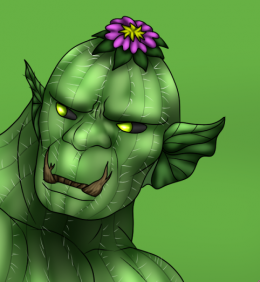
Yanar don’t have a formal concept of politics, largely because their psyche is often in flux, and because longevity makes appointing rulers very difficult for longer periods of time. Yanar have the concept of trust investment, in which an individual or group of Yanar (or even a non-Yanar) may simply enjoy the silent approval of the other Yanar to speak in their name or act in their best interest. This concept is never really spoken out loud, but heavily implied when a Yanar suggests an individual to deal with the group’s issues and no-one else speaks up about it. Yanar don’t really have power struggles like Ailor society does, though some cases contention can occur where a Yanar’s personality changes within the group, resulting in an urge or ambition for power, which can sometimes cause a power struggle. Yanar often have a difficult time accepting rule from a person who thinks they deserve it, as opposed to a person who was silently and passively appointed to the position out of comfort of the others. That all being said, Yanar are incredibly flexible when it comes to adapting to existing hierarchies in other states, as they generally wish to thrive wherever they can, while paying homage to the order of things wherever they integrate.
Culture
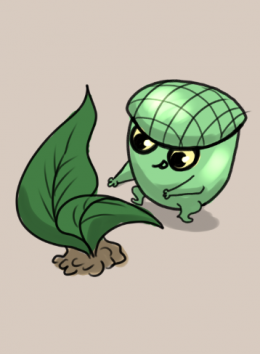
Yanar culture mostly breeds out of the idea of sharing a communion, a theme that perpetuates itself throughout all their ideologies and actions. The easiest way this can be observed is in the charitable nature of Yanar towards each other, freely sharing resources, food and clothes. Private property rarely exists among the race, and when it does, it is often for a very specific reason: for example, a Yanar may hold onto an item when they know the others won’t understand its purpose, or won’t respect its purpose. Aside from their own sharing notions, Yanar are also charitable to other races, Cielothar in particular. In many ways they adopt Cielothar principles and cultural notions, mostly related to their clothing and jewelry, but also life views in general. That being said, Yanar are able to physically and mentally alter themselves to supplant the need for the Avanthar-Cielothar symbiotic relationship, thus creating their own protector class Yanar to ensure that the race as a whole does not become co-dependent on another species. This does however often create a clear distinction between Yanar that are part of the collective for protection, and Yanar who protect the collective. Physical difference can also be extreme, ranging from more childlike Cielothar-like Yanar who provide the food, and tall, broad Orc-like Yanar which protect the Yanar Colony from outside attacks.
Yanar do not have traditional marital unions like Ailor or Altalar do. Yanar cannot conceive a child together, which often leaves them with a sense of emptiness or non fulfillment when sharing a life. Yanar marry in much the same manner as Cielothar do, and are inherently monogamous—though outlying cases have been known to showcase polygamy or partner swapping, particularly because of the age of Yanar. Between a Yanar and non-Yanar married couple, Ovalating usually solves the problem of not being able to conceive a child together, as Ovalating takes the essence from both parents. For two Yanar who are married however, such options aren’t available since Ovalating does not work with other Yanar. Yanar who are married together have, as such, found another way to reach this specific satisfaction of offspring that belongs to both of them: the practice of Graftalation.
Graftalation uses much of the same mechanics as Ovalating, but uses a surrogate tree and the Shape Essence of both Yanar. While the Shape Essence itself does not contain anything useful for another Yanar, when a tree fruit is covered with the Shape Essence of two Yanar that is properly mixed, the fruit will slowly change into a Yanar Fruitling over the course of three days. The base fruit can be anything from an apple, to an orange, or even a banana. Then after about a month, the Yanar Fruitling will hatch and create a Yanil: an organism best described as a plant-like imitation of an animal. A Yanil is much like a Yanar in that it is a plant-like re-interpretation of another living creature, except that it takes the form of a domestic animal rather an a humanoid. They are unable to speak, but have heightened intelligence to the point where they can develop a distinct personality and memories, a clearcut persona mixture between both parent Yanar in fact. They have a strong connection to the parent Yanar, and while others might see them as animals since they are often quadruped creatures, Yanar often treat them as if they are their own children in their 10 year life span. Yanil appearance depends on the fruit type used to create the Yanil, below is a list of possible outcomes.
- Apple, results in a hedgehog-like Yanil, though the spikes are soft and flowery
- Apricot, results in a rat or rodent-like Yanil
- Banana, results in a small primate-like Yanil with long arms
- Cherry, results in a songbird-like Yanil
- Fig, results in a rabbit-like Yanil
- Bundle of Grapes, results in a small woolly sheep-like Yanil
- Melon, results in a small (goat sized) pony-like Yanil
- Lemon, results in a cat-like Yanil
- Mango, results in a fox-like Yanil
- Olive Branch, results in a snake-like Yanil
- Orange, results in a small dog-like Yanil
- Pear, results in a pygmy pig-like Yanil
- Pineapple, results in a loud bleating goat-like Yanil
- Pumpkin, results in a small lamb-like Yanil
- Strawberry, results in a guinea pig-like Yanil
- Grapefruit, results in a ferret-like Yanil
Creating a Yanil is not a practice solely limited to married Yanar. Close friends often create a Yanil as well to give a physical representation to their friendship, as it also strengthens the bond between them. It is technically possible to include a non-Yanar as well by having both parents Ovalate with the Shape Essence of a non-Yanar, though this is often frowned upon, particularly because the concept of a Fruitling is considered a holy tradition with religious sentiment, and should remain a Yanar-only activity. Yanil creation is also in many ways a very communal thing. Yanar are able to graft fruits on trees, even when they technically aren’t fruit bearing trees, to the point that a Yanil may grow from the tree’s nutrients. This results in the creation of so-called Yanassil: large trees upon which Yanar couples and friends graft their Fruitlings in large numbers. These trees thus stand, filled with a wild variety of fruit and Fruitlings, and become a central location for Yanar religious worship of the Fated Faith.
Religion
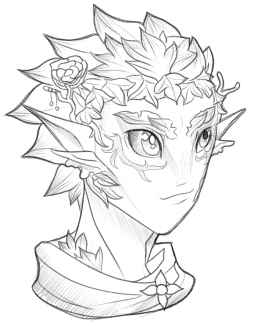
Religion among the Yanar is difficult to understand to outsiders, even more so to the Elven races. In essence, the religion—which is named the Fated Faith—is based on the creation of the Yanar by Estel, but the Yanar do not recognize Estel as their highest being. The Yanar believe that foremostly, the Nenya are their guides and protectors: prophets of the words and laws of Estel. These words and laws are also rather complex to explain, they are not a certain set of codified laws like “Do not steal” and “Do not murder”, they are simply the general understanding that Yanar were created with a purpose, and that purpose itself is commutable to the situation and global threat at hand. For example, during the days of the Demon Invasion, Yanar were messengers who warned of the impending fall of the Elven Empire. When the actual invasion occurred, many Yanar switched their needs to protectors, while centuries later when Ailor wars occurred, they took on a more healing and caretaking role, before turning more militaristic again when the Bone Horror Crisis happened. Yanar religion as such dictates a world view where the greatest risk to all life (though more specifically all plant/animal life in nature) must be assessed, and combatted to the best of their abilities. The Nenya are their prophets, Estel is their creator, but neither are really their gods, or origins.
The Yanar believe the highest power in their spiritual faith is the Fated Ones. Who exactly the Fated Ones are is not entirely clear since no Yanar has ever really been able to write a thesis on it before being contradicted by another group of Yanar. The truth is that Yanar were never truly told or informed of what the Fated Ones were by the Nenya or Estel before they disappeared from Aloria, though the Yanar continue to pay homage to the Fated Ones to this day. It is said that the Fated Ones created Estel, who in turn created Nenya, meaning that the origin of all things for the Yanar is the Fated Ones. They believe the Fated Ones lived in an ascended state of communion with Aloria itself; a symbiotic relation with the world where their thoughts and feelings carried far and wide through nature, and mixed with others who were equally connected. The Fated Ones were said to have fallen at the hands of corruption, though again, what this corruption was has never been fully explained. The Yanar simply believe themselves to be the protectors that the Fated Ones wished for in their hour of need, thus continuing to see them both as gods and masters worthy of praise and homage, though they equally praise Estel as their lesser creator, thus allowing them to interface with Faith of Estel worship in a lesser degree.
Yanar worship frequently takes place around a Yanassil, large Fruitling trees that Yanar use to breed their Yanils. These worships usually involve communal feasting, drinking, dancing and praying. Yanar do not engage in sacrifices or offerings of any kind, since they believe the will of the Fated Ones is engrained in all things natural, and as such, offering food as a sacrifice would be like offering a god a piece of themselves. That being said, some twisted and warped Dulofall Yanar have been known to engage in sacrifices of other races. They see the lesser races as corrupted beings who maligned the Fated Ones and brought the ugly reality of dominance over nature into the world, perpetuating it. Yanar do not have priests or oracles. Religion to them is practiced communally, by all equally.
Many Scholars have speculated that the Fated Ones are actually the Seraph Civilization since many of the hints point in their direction, though a clear cut conclusion has never been found, purely because many contradictions exist also. Most notably in the fact that the Seraph dominated nature, they did not live in harmony with it. Some other Scholars yet insist that it might have been a civilization that came before the Seraph or after, or that traditional understandings of the Seraph are far too limited because of the lack of historical records on a civilization that died seven thousand years ago.
Trivia
- Yanar don’t formally have a gender either mentally or physically, though often choose a preferred gender and ask others to use the right pronouns, just for practicality sake. Yanar often struggle with the concept of self identity since their personality is a substrate of another, and their gender does not present itself as traditionally as among other races.
- There is such a concept as excess-Ovalating. In some cases if a Yanar consumes the Shape Essence of one particular race many times over a short period of time, even their normally green skin-tone may change to something resembling the Shape Template more. This can even go as far as turning the skin greenish pink or pinkish green.
- Despite Yanar not having a gender, Yanar marriages are often between Yanar who believe themselves to be more female and a Yanar who believe themselves more male. While same sex-belief Yanar marriages exist, they are rare. It is not known why this occurs naturally.
- Yanar, to conventional understanding through Soul Magic, don’t have a soul. When they die, Soul Essence does not dissipate, nor can it be removed from them, though they can be Demonically Possessed. It is not known why this occurs, but some Scholars have speculated it is because what passes for their souls are made up of recycled Soul Essence in nature.
- A small Unionist converted or Unionist-minded cult of Yanar exists that are absolutely desperate to procure Shape Essence produced from the Emperor of the Regalian Empire, and would pay handsomely to anyone able to procure and store it.
| ||||||||||||||||||||||
| Accreditation | |||||||||
|---|---|---|---|---|---|---|---|---|---|
|
| ||||||||